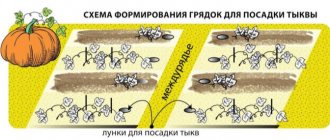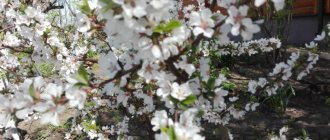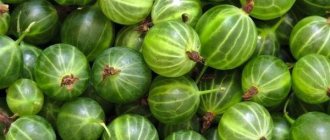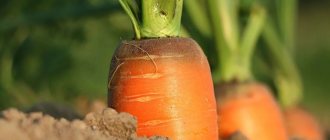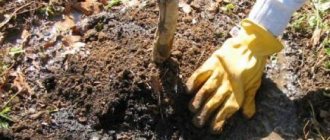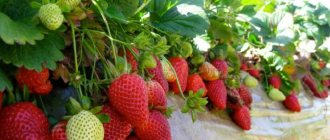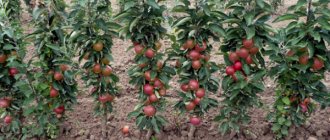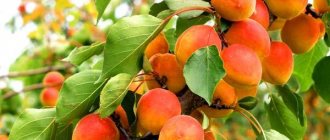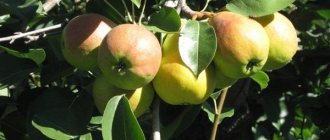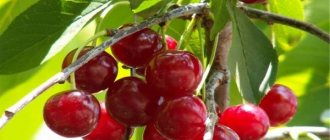Getting to know the plant
Cherry plum comes from Western and Central Asia. In addition to the usual one, there are Iranian, Caspian, Fergana and Syrian varieties of the plant. Cherry plum is a multi-stemmed tree or shrub, the height of which ranges from 3 to 10 meters. The lifespan of a tree is up to 50 years. The habitat of wild cherry plum is very wide. It is found in the Tien Shan and the Balkans, in Transcaucasia and Ukraine, in Moldova and the North Caucasus. Cultivated cherry plum is also widespread; it is cultivated in many regions of Russia, Western Europe, Ukraine and Asia.
Mountain cherry plum of the Tien Shan
Advantages and disadvantages
Cherry plum is not only useful. It is distinguished by high productivity and disease resistance. Besides, she's just beautiful. It blooms in early May. A spring tree strewn with white or pink flowers seems to float in the blue sky. The delicately scented flowers attract many insects, and during the flowering period the tree “buzzes” like a beehive. Due to its decorative qualities, cherry plum is used in landscape design.
The tree is no less beautiful during the fruiting period. The branches, abundantly strewn with fruits, bend down. Ripe cherry plum can have a variety of colors: yellow, green, pink, purple, red, yellow with red barrels, even almost black berries. Depending on the variety, ripening occurs between June and September.
Cherry plum is not as sweet as plum. Compared to plums, they contain more calcium and less sugars. She is unpretentious, but is afraid of severe frosts. However, frost-resistant varieties bred by breeders make it possible to grow the crop in areas with a rather harsh climate.
Features of culture
Cherry plum has become widespread due to a number of attractive qualities:
- The tree produces the first berries a year after planting; after 2–3 years, the harvest can be up to 15 kg per tree; later, the plant can produce up to 40 kg of berries;
- the crop is undemanding to soil composition;
- easily tolerates heat and drought;
- resistant to both diseases and pests.
However, cherry plum also has a number of disadvantages. The main ones are:
- self-sterility of most varieties;
- short period of winter dormancy;
- early flowering.
Due to these features, to obtain good harvests, it is necessary to plant several varieties nearby for cross-pollination. A short period of dormancy and early flowering are fraught with damage to the tree by spring frosts. And even in frosty winters in regions where the temperature drops to -300C and below, the plant must be covered.
Planting cherry plum
In order for the plant to take root and produce abundant harvests, it is necessary to take into account all its preferences when planting. It is better to plant, especially in the middle zone, in the spring. It is very important to plant before the first leaves appear. This will shorten the period and make the adaptation period easier for the plant. It is recommended to purchase seedlings in the fall. For the winter, they are buried in an inclined position and covered. Seedlings with a closed root system can be planted in summer.
Site preparation and planting
The first step is to choose a suitable location. Cherry plum loves sunny places protected from the wind. If planted correctly, the harvest will appear earlier and will be greater than that of plants placed in less favorable conditions. Cherry plum loves neutral soils, so it is advisable to treat acidic soil with dolomite flour, and alkaline soil with gypsum.
The root system of cherry plum is very developed, but is located shallow. This allows it to be “settled” where groundwater is high. It is better to prepare the planting hole in advance. Its dimensions should be 60x60x60cm. The pit must be prepared in the fall, filled with good soil and humus, and added with ash. Potassium and phosphorus fertilizers are also applied there, and abundant watering is carried out.
In the spring, before planting, the bulk of the soil is removed, a mound is made in the center, along which the roots of the seedling should be further distributed. If some of the roots are sick or have died, they must be removed using a clean, disinfected tool. Dried roots can first be soaked in water for several hours.
A peg at least 1 m high is driven in next to the seedling. The roots of the plant are covered with earth, leaving a depression at the edges of the hole for watering. For plants with a closed root system, the roots along with the lump are placed in a hole and covered with excavated soil mixed with humus and fertilizers. There is no need to make a mound. Before planting a tree with a closed root system, the soil surrounding the roots should be moistened so that it does not crumble during planting. In cases where the root ball is in the mesh, it is not removed. The mesh will rot over time and will not interfere with the development of the root system. However, before placing it in the ground, it is better to open the mesh. With any planting method, the root collar should remain on the surface. If the seedling is grafted, then the grafting site should also be above the soil level.
Planting a cherry plum seedling
The seedling is tied to a peg for fixation. The soil around the tree is trampled down and watered at the rate of 15 liters of water per plant. After planting, the tree must be pruned by 20–30 cm. When planting several seedlings at the same time, the distance between them should be 2.5–3 m. Tall varieties are placed at a distance of 6 m from one tree to another. The trunks of young plants should be covered with a net before winter to protect them from rodents. After planting, it is recommended to mulch the circle near the trunk with straw or sawdust to a depth of 5 cm.
If over time it turns out that the tree is still out of place, it can be transplanted. This should be done in early spring. The basic principle is that the root system should be protected by a large lump of earth. They dig in the tree at the width of the crown, then surround it with a ditch two shovels deep and carefully dig up from below. It is better to move the lump on a sheet of iron or linoleum. A large tree will have to be moved using additional devices, such as a winch. After transplanting in the first year, it is advisable to limit fruiting by removing some of the fruits.
Choice of neighbors
Since the majority of cherry plum varieties are self-sterile, it is necessary to plant pollinating varieties next to them. These include cherry plum Traveler, plum Red Ball, Skoroplodnaya. You can choose other varieties of plums that bloom at the same time as the planted cherry plum variety. For mid-late varieties, cherry plum varieties Asaloda, Vitba, Mara are suitable. Some varieties are well pollinated by Chinese plum.
Cherry plum Red ball - a good pollinator
In addition to many self-fertile varieties, there are also self-fertile varieties. These include the Kuban Comet, Cleopatra - partially self-pollinating. Although these varieties are capable of producing berries without additional pollinators, planting other cherry plum varieties nearby will significantly increase yields.
Partially self-fertile variety Kuban Comet
In gardens, fruit and ornamental plants grow in close proximity. But not all plants combine well with each other. A negative reaction occurs when the root systems are located at the same level and compete for nutrients, as well as when one of the plants secretes substances that are harmful to the other. Next to the cherry plum, you should not plant pears, walnuts, cherries, cherries and apple trees. However, some experts claim that cherry plum feels good next to an old apple tree.
The Cleopatra variety can also bear fruit without neighbors
You should not combine the plant with some decorative neighbors. For example, a birch tree in a garden should be located at a considerable distance from fruit trees, since its powerful root system oppresses its neighbors.
Cherry plum Vitba is a good neighbor for other varieties
Pruning cherry plum and crown formation
Like all fruit crops, cherry plum is subject to sanitary pruning and crown formation. You can carry out sanitary pruning yourself in the autumn. Old, inward growing, diseased and other branches and shoots are cut into a ring. The crown is thinned out if the shoots are crowded inside the crown.
If you lack skills, it is better to entrust the formation of the crown to a specialist. Cherry plum forms fruits on main or peripheral shoots of different ages, which is why it differs from other fruit crops. It will be difficult to carry out correct formative pruning on your own, without knowledge of the biology of the crop.
Formative pruning on cherry plum is best done in the spring, but before the buds open. In winter, formative pruning cannot be performed due to the fragility of the branches, and in summer, the tree suffers for a long time due to wounds and does not overwinter well. Correct formative pruning helps to prolong fruiting and the fruiting period of the crop, rejuvenates it, and to some extent protects it from diseases, especially infectious ones. At the same time, there are varieties that require crown formation in autumn. For example, the “Kuban Comet” variety. Therefore, it is better to invite a specialist to form the crown.
Purchase of seedlings and methods of propagation
In order to grow a healthy, viable plant, it is important to have good planting material. It can be purchased, or it is also easy to obtain seedlings yourself by cuttings or from seeds.
Purchasing seedlings
When choosing a tree with a closed root system, you need to be careful about the size of the lump. The larger the plant, the more roots it has, and the larger the clump should be. The soil should not be overdried and loose, otherwise it may crumble during transportation and planting. The roots should be sticking out from the bottom of the container. This is a guarantee that the plant was not placed in it before the sale itself. You should also carefully examine the bark. There should be no cracks or scratches on it, and it should not be wrinkled.
For bare-rooted seedlings, make sure the roots are alive. The tree must have at least 4 - 5 main roots. To make sure they are not dry, you should ask the seller to make a cut. The flesh of the tip when cut should not be brown, but white. There should be no swelling on the roots that occurs with cancer. A two-year-old seedling has 2–3 branches.
Propagation by cuttings
Propagation by green cuttings is suitable for all varieties of cherry plum. They take root well and develop quickly. Many varieties can also be propagated from woody cuttings, but this method is not suitable for everyone.
Green cuttings
Green cuttings are cut in the 2nd - 3rd decade of June. For their preparation, shoots of the current year are used. Green cuttings must be planted in a greenhouse, which will have to be prepared in advance. Instead of a greenhouse, it is quite possible to use a film greenhouse with soil prepared for plant propagation. The bed is dug to a depth of about 40 cm, a drainage layer of crushed stone or pebbles 15 cm thick is laid down. The drainage is covered with fertile soil to a depth of 15 cm on top and covered with a 10 cm layer of a mixture of peat and sand. The entire “pie” is covered with 3 cm of clean sand on top. The bed must be compacted to make it easier to moisten it evenly in the future.
Cuttings are cut when the bases of young branches turn red and harden. For propagation, shoots 25–30 cm long are chosen. Shoots are cut in the evening or in the absence of sun to reduce moisture loss. The prepared material is immediately placed in water.
It is best to plant green cuttings in a greenhouse
Then, with a clean tool, cuttings are formed that have 2–3 leaves and a lower part of 3 cm. For the cutting, take the middle of the shoot. The top is cut above the bud at a distance of 0.5 cm perpendicular to the shoot, the bottom is under the bud, the cutting angle is 450. The finished cuttings are immersed with their bases in the rooting solution for 18 - 20 hours.
After this, the treated cuttings are placed in a well-moistened bed at a distance of 5 cm from each other and to a depth of 2.5 - 3 cm. You can arrange them in rows, the distance between which should also be 5 cm. The planting should be moistened 2 - 3 times a day at using a hand sprayer or watering can.
Rooting occurs at a temperature of 25 - 300C. The yield is 50 - 60%, while the formation of roots takes from 2 weeks to one and a half months, depending on the type.
Lignified cuttings
To form lignified cuttings, ripe, strong annual branches are used. They can be harvested from autumn after leaf fall until early spring, until the buds begin to swell. Root shoots are best suited for such cuttings, which still have to be removed. Cuttings are formed from the middle and lower parts of the shoots so that their thickness is in the range from 7 to 12 mm, and their length is 20–30 cm. If you plan to plant them in a greenhouse, then you can take blanks 4–10 cm long.
Preparation of lignified cuttings
Cuttings planted in open beds immediately after the leaves fly off take root well. For such cuttings, the upper cut should be oblique so that moisture does not linger on it. The cuttings are treated with a rooting agent and then placed on the bed in grooves 15 to 20 cm deep. The cutting is immersed 2/3 into the groove. Before planting, a mixture of sand and peat is poured into the groove. The tip of the cutting should rest against the bottom. The soil is added in layers, thoroughly compacted. When its level is level with the ground, a groove is formed around the cutting for watering. After watering, pour soil into the formed depression. After winter frosts, the soil around the cuttings must be thoroughly compacted again. A year after planting, the rooted cuttings can be transferred to a permanent place.
Growing from seed
Growing cherry plum from seed is a slow, but uncomplicated process, accessible to everyone. First you need to prepare the bed. To do this, the ground is dug up to the depth of a spade bayonet; humus must be added to the dug soil at the rate of 3–4 kg per square meter and a glass of wood ash. It is not recommended to use mineral fertilizers and manure to improve soil quality.
For future planting, select ripe berries, peel the seeds from the pulp and wash thoroughly. The bones are dried on a towel or soft paper; they dry within several hours.
Recent Entries
Lilac perennials that are beautiful, compact and do not crowd out other plants Why when buying seedlings you should not take the sellers’ word for it and how to determine the age of the plant using 3 signs Tomato seedlings have turned purple or whitish: why the color has changed and how to save the plants
The prepared seeds are placed on the bed at intervals of 70 cm in each direction, planting them to a depth of 5 cm. The bed is compacted.
In the year of planting, shoots do not appear. The next year, at the beginning of spring, small seedlings appear in the garden bed. Each has 2 leaves directed in opposite directions. Below them the root collar is visible; it is lighter than the main stem. Further growth occurs between the leaves, an upward shoot is formed, on which new buds are formed.
In sunny places the shoots develop quickly, but at the beginning of summer their growth stops. Buds form at the ends of the shoots, from which new shoots will appear the following year. The crown begins to take shape in the second year. Two-year-old seedlings can be transplanted to a permanent place.
A sign of good future harvests is growth. Those trees with large growth will bear fruit well. The first berries appear 3 years after transplantation. This method of propagation allows you to obtain plants that are not afraid of frost.
Protection from pests and diseases
In spring before the buds swell
- We cut out dry, diseased branches damaged by bark beetles (if the damage is severe, the branches dry out) and scale insects (on damaged branches you can find barely visible brown-gray shields up to 3 mm long).
- We spray the trees and the soil under them with a solution of urea (700 g per 10 liters of water) or ammonium nitrate (1 kg per 10 liters of water).
- To destroy fungal infections, mosses and lichens, once every 4 years we spray the trees with iron sulfate (300 g per 10 liters of water).
Beginning of bud burst (green cone phase)
- To destroy the causative agents of clasterosporiasis and moniliosis, we spray the trees with 3% Bordeaux mixture.
- For prophylaxis against plum pollinated aphids, you can use one of the following insecticides: novaction (13 ml per 10 liters of water), fufanon (10 ml), sumithion (10 - 24 ml). You can also use a decoction of a mixture of onion peels and garlic cloves or an infusion of chamomile leaves and inflorescences instead.
Protrusion of buds (white bud phase)
- Against sucking and leaf-eating pests (mites, aphids), trees can be sprayed with one of the following insecticides: Novaktion, MKS, Fufanon, Karate, Karate Zeon. Instead, you can also use a decoction of yarrow, an infusion of leaves and inflorescences of chamomile, garlic or onions.
- If trees were damaged by clasterosporiasis or monilial burn in the previous year, they can be treated with azophos (100 g per 10 liters of water) or a 1% solution of Bordeaux mixture.
Isolation of buds
- If the number of plum sawfly is high in the previous year, we treat the trees with Fufanon or Novaktion.
End of flowering
- In cases of severe infection with clasterosporiosis or monilial burn, we treat the trees with a 1% solution of Bordeaux mixture.
- If there is a high number of sawflies and leaf-eating pests, as well as aphids, we treat them with Novaktion and Fufanon.
Fruit ripening
- We cut out drying branches affected by monilial burn.
- We treat wounds (if any) that may appear as a result of damage by bark beetles.
- When wormy carrion affected by the plum codling moth appears, we put catching belts made of burlap, wrapping paper, and corrugated cardboard on the trunks (they should be removed and burned immediately after harvesting).
After harvest
- When the slimy sawfly appears en masse, we spray the trees with Novaktion and Fufanon.
After leaf fall
- We rake and remove fallen leaves from the garden (they can be burned or buried in the ground), in which many overwintering pests and pathogens of clasterosporiosis, coccomycosis and other spots accumulate.
- To destroy wintering sawflies and weevils, we dig up the soil in the tree trunk circles.
Pruning cherry plum
If a seedling is grown in the form of a tree, then in the first 3-4 years we form a sparsely tiered crown. We lay the main branches (4-5 pieces) at a height of 70-80 cm from the ground.
It is impossible to perform severe pruning of cherry plum seedlings, as this stimulates the growth of shoots, thickening of the crown and a decrease in yield. Fruit-bearing trees just need to be thinned out and damaged and diseased branches removed.
The plant can also be formed into a bush, in which case pruning the cherry plum will consist only of thinning the crown and shortening shoots that are growing too rapidly, and care will be greatly simplified.
Grafting cherry plum onto plum
We graft cherry plum onto a young plum tree (no older than 5 years). It is best to do this at the end of March - at the beginning of April, when active sap flow is just beginning in the trees, and the buds have not yet had time to bloom.
The most suitable vaccination methods are the following:
- Budding - in a T-shaped incision or butt;
- Improved copulation;
- Cleft grafting;
- Vaccination for the bark.
Of the above, the simplest method is the last one, and therefore, in most cases, novice gardeners use this one. We will tell you about it in detail.
Grafting cherry plum by the bark - step-by-step instructions.
- We select a healthy branch on a young tree and cut it down into a stump with a garden saw. Next, we cut off the branches extending from the stem with pruning shears.
- On a scion-cutting that was cut in the fall and stored properly, at an angle of 30 degrees we make an oblique cut about 3-4 cm long.
- We make a split in the middle of the cut (“tongue”), which can significantly increase the chances of survival.
- On the side of the rootstock, carefully cut off the top layer of bark and make a “tongue” of the same size.
- We connect the scion to the scion in such a way that the “tongues” interlock with each other, and the cambial layers of the plants coincide.
- We tie the grafting site with plastic tape, and cover all sections with garden varnish.
If after 12-14 days the scion has not dried out, and during active sap flow the buds on the cuttings have turned green, then we can consider that the grafting was a success. Otherwise, you need to try to re-graft the tree with cuttings with “dormant” buds. But keep in mind that in late spring and summer, the scion’s fusion with the rootstock is much worse.
Care
Caring for young trees includes:
- weeding;
- timely watering;
- crown pruning;
- feeding;
- fight against insects and diseases.
Trimming
Pruning should be done in early spring. The first pruning is carried out during planting. Subsequently, the branches of an adult plant are pruned if growth does not appear. The upper branches and trunk are also shortened if they have become too tall. In this case, pruning by more than 1 m is not allowed. Otherwise, vertical shoots of great height will appear in place of the cut shoot.
Pruning by year
The purpose of pruning is also thinning. At the same time, the weaker of the intersecting branches, the bent branches that interfere with others, are removed. This is done to improve lighting. All diseased branches and those directed into the crown are also removed.
Top dressing
In the first year, the seedling does not require fertilizing, since a sufficient amount of nutrients is introduced into the hole when planting. Subsequently, once every 3 years, organic fertilizers are applied to the groove near the tree trunk at the rate of 10 kg per 1 sq. m. m crown.
Unlike organic fertilizers, mineral fertilizers must be applied every year. Before flowering, the plant is fed with ammonium nitrate at the rate of 60 g per 1 square meter. m. In June, it is necessary to add fertilizers containing potassium and superphosphate to the soil at the rate of 50 g and 120 g per 1 sq. m. m. Most of all, cherry plum requires nitrogen and potassium; it needs phosphorus fertilizers much less. Therefore, the first fertilizing with nitrogen fertilizers can be carried out at the very beginning of the season, in early spring.
What are the benefits of cherry plum fruits?
The value of cherry plum lies in its tasty and healthy fruits, which differ in dietary characteristics. They contain a low amount of sugars, and therefore are slightly inferior in taste to plums. At the same time, cherry plum surpasses this fruit in terms of the content of useful components.
The fruit contains many vitamins, organic acids, and microelements. The fruit also contains healthy pectin.
The optimal set of valuable components, low sugar content and low calorie content help to use cherry plum in dietary nutrition if you are overweight. The fruit can be consumed during pregnancy. It is useful for children and elderly people. Fresh cherry plum fruits help cope with vitamin deficiencies, eliminate digestive problems and circulatory disorders.
Cherry plum diseases
Cherry plum, along with other stone fruits, is susceptible to various diseases. The table below shows the symptoms of diseases and methods of treating them.
Table: cherry plum diseases and their treatment
| Disease and pathogen | Signs | Control measures |
| Brown spot. Caused by fungi | Spots form on the leaves, the color of which depends on the pathogen (brown, yellow or ocher). Later, black dots are discovered - spores. The middle of the leaves is crumbling, the leaves are falling off | Diseased leaves must be destroyed. Trees are treated with 1% Bordeaux mixture 3 times: during budding, immediately after flowering and 2 weeks after the 2nd treatment. In case of severe damage, the plants should be sprayed again 3 weeks before harvesting the fruits. |
| Coccomycosis. The causative agent is a fungus | Purple-red or brown spots form on the upper part of the leaves. The underside of the leaves is covered with whitish tubercles and pads with spores. Not only the leaves suffer, but also the fruits. They change shape and you can't eat them. | Infected leaves and fruits are collected and burned. In the spring after flowering has stopped and in the fall after berry picking is completed, the trees are sprayed with a 1% solution of Bordeaux mixture |
| Moniliosis, moniliosis burn. Fungal disease caused by the ascomycete Monilia | The branches turn brown, wither, and the fruits rot. Gray growths form on the berries | Affected parts of plants are cut off and burned. Treatment is carried out in 3 stages: when the leaves bloom - 3% Bordeaux mixture, before the flowers bloom and after flowering - 1% Bordeaux mixture |
| "Pockets." Fungal disease | The set fruits stretch out, taking on the shape of a bag. No bones are formed. The berries do not ripen, turn brown and dry out, then fall | Diseased parts of plants are collected and burned. Treatment with a 1% solution of Bordeaux mixture is carried out 2 times: during budding and after flowering |
| Hole spot (Clasterosporiasis). The causative agent is a fungus | Brown spots with a red border form on the leaves. The spots are fading. The buds turn black, the fruits become covered with spots, which later swell. The fruits dry out | Diseased parts of plants must be destroyed. Trees are treated with 1% Bordeaux mixture 3 times: during budding, immediately after flowering and 2 weeks after 2 treatments. In case of severe damage, the plants should be sprayed again 3 weeks before harvesting the fruits. |
| Brown fruit mite | The larvae appear in the spring when the buds open. The larvae molt, their skins give the leaves a silvery color. Leaves turn brown and fall off | Cleaning the bark of dead tissue. Treatment with insecticides (Fufanon, Karate) before bud swelling and during budding |
| Slimy sawfly | Feeds on leaf blades, leaving only veins | Autumn collection of fallen leaves and fruits. Spraying trees in July or early August with Fufanon or Novoaktion |
| Plum aphid | The insect extracts juice from leaves and young twigs. Leaves change shape, turn yellow and fall off | During the budding period, trees are sprayed with Karbofos or Sumition, carefully treating the lower surfaces of the leaves |
Spraying with insecticides is also effective against different types of codling moths, as well as the yellow plum sawfly. Prevention from all types of lesions consists of cleaning up fallen leaves, removing diseased parts of plants, and proper feeding.
Brown spot spots on leaves
When growing cherry plum, other problems are possible. A well-bloomed tree may produce many fruits that will fall before they are fully ripe. Most often this happens when the watering regime is violated. Abundant fruiting requires plenty of moisture. Watering should be done regularly into a ditch dug along the border of the crown.
Moniliosis affects not only leaves, but also fruits
If the tree does not bear fruit, the reason is most often the lack of pollinators. Since most cherry plum varieties are self-sterile, having several identical trees will not solve the problem. To get a harvest, you will have to plant a tree of a different variety nearby.
It is important to know
When planning to plant cherry plums, keep the following in mind:
- sometimes you can find southern varieties on sale that are completely unsuitable for growing in the Moscow region,
- a small part of cherry plum varieties are self-fertile, some are partially self-fertile, but most are self-sterile. But even if you choose a self-fertile variety, it is better to provide it with the company of other varieties blooming at the same time. Then the plant will bear more fruits, which will be larger than those of the cherry plum growing alone.
Cherry plum - planting and care
Features of growing cherry plum in areas with harsh climates
Despite all the unpretentiousness and undemandingness of soils, it is better to grow zoned varieties in different regions. A native of the southern regions, thanks to the efforts of breeders, cherry plum has also conquered the harsh northern regions.
Middle zone and Moscow region
To withstand the changeable climate, recurrent frosts and other delights of the risky farming zone, it is worth paying attention to varieties specially bred for the Middle Zone. Among them, the Rocket Seedling stands out - the most frost-resistant and the Tent - the largest-fruited.
Cherry plum Mara is good for the Moscow region
The time of ripening of the berries is also very important. In the last days of July - the very beginning of August, Vetraz, Monomakh, Nesmeyana bear fruit. Later, in mid-August, Apricotovaya, Persikovaya, Kubanskaya Comet, Anastasia, Sarmatka, Karminnaya Zhukova, Chuk, Comet Late ripen. Mara, Skoroplodnaya and Zlato Scythians are good for the Moscow region. In addition to the Rocket Seedling, the Gift to St. Petersburg and the Vladimir Comet are safely surviving the frosts.
The variety Gift to St. Petersburg is not afraid of the vagaries of the weather
Siberia
Particularly difficult conditions for cherry plum are observed in Siberia. Thaws followed by severe frosts are dangerous for her. Weak frost resistance and a short period of winter dormancy do not allow the southerner to take root in these parts. But in Siberia, hybrid varieties bred specifically for these places are successfully grown.
Table: Cherry plum varieties for Siberian gardens
| Name | Ripening period | Productivity, kg | Characteristics of berries |
| Scarlet Dawn | End of July | 8 – 15 | Bright red, sweet and fresh, 11–15g |
| Northern dessert | 1st ten days of August | 4 – 6 | Bright red, dessert, 10 – 17 g |
| Honey | 2nd – 3rd decade of August | 3 – 8 | Red, dessert, 13 – 19 g |
| Amber | Last ten days of August | 12 – 18 | Yellow, sweet and sour, 12 – 16 g |
Special zoned varieties Raduga, Mars, Almond and Rubin grow well in Siberia. They all require neighbors - pollinators. The exception is the partially self-fertile Yantar.
The Honey variety grows even in Siberia
How does cherry plum propagate?
Reproduction of cherry plum can occur in several ways:
- through vaccination;
- by seed method;
- layering.
A fairly common way in which cultivars are propagated is by grafting. But there are also some disadvantages. Grafted plants lose frost resistance and can freeze out almost completely in severe winters.
Cherry plum cuttings
The method of rooting cuttings and layering has also become quite widespread. For better survival, they can be placed in a greenhouse. Don’t forget about growing your own cherry plum. It is resistant to frost and recovers well after freezing in severe cold.
